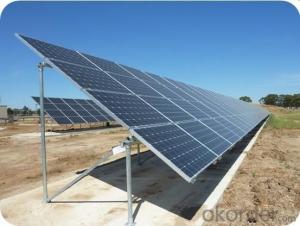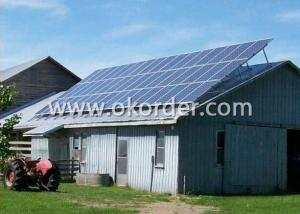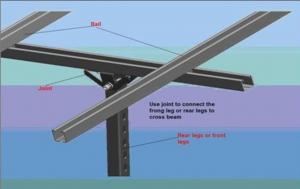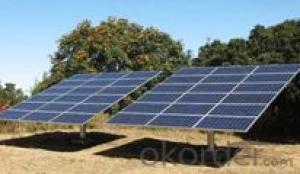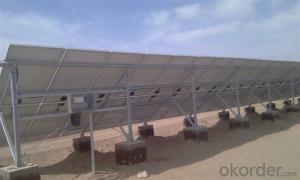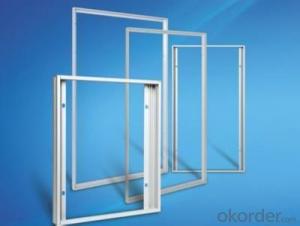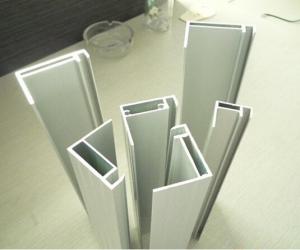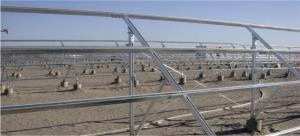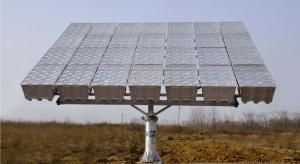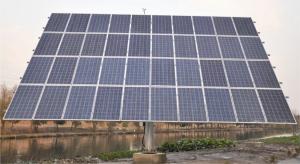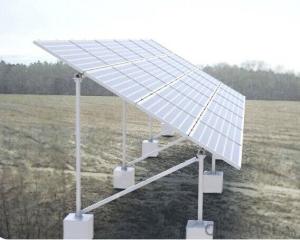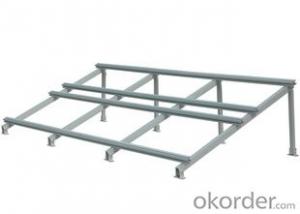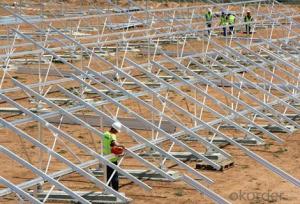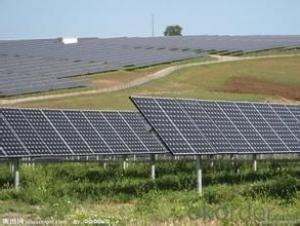Solar Panel Mounting Bracket
- Loading Port:
- China Main Port
- Payment Terms:
- TT OR LC
- Min Order Qty:
- -
- Supply Capability:
- -
OKorder Service Pledge
Quality Product, Order Online Tracking, Timely Delivery
OKorder Financial Service
Credit Rating, Credit Services, Credit Purchasing
You Might Also Like
Product Description
Solar Panel Mounting Bracket
1, mainly used in large-scale photovoltaic power station project, the ground used to support the photovoltaic panels components.
2, product main frame profile is made of Q235B steel plate a cold bending forming, economic, durable, easy to install.
3, surface using hot-dip zinc treatment, durable resistance to corrosion.
4, our products have been in China, gansu, shanxi, shandong, sichuan and other large power station project put into use, obtained the customer consistent high praise.
| Model Number | HL-PS-001 |
| Application | Commercial |
| Installation Site | Open Area |
| Material | Steel |
| Standard | GB,AISI,ASTM,BS,DIN,JIS |
| Installation Angle | According to customer's request |
| Installation Height | According to customer's request |
| Wind Load | 90m/s |
| Snow Load | 1.8KN/m² |
| Solar Panel Size | Any |
| Warranty | 10 years |
| Service life | 25 years |
| Packaging Detail | Standard Export Carton, Plywood Pallet and Case. |
| Delivery Detail | 1-2 weeks according to the order quantity |
Our Services
1. Can provide the customer reference samples
2. Support customized to meet the need of customers design and processing.
3. Provide after-sales construction guidance.
- Q:Can a solar mounting system be used with solar-powered cars?
- No, a solar mounting system is designed to support and position solar panels, typically for stationary applications like rooftops or ground-mounted solar arrays. Solar-powered cars have their own integrated solar panels and do not require a separate mounting system.
- Q:Can a solar mounting system be used with solar-powered interstellar travel?
- No, a solar mounting system cannot be used with solar-powered interstellar travel. Interstellar travel requires a much more advanced and powerful propulsion system that can generate immense thrust to overcome the vast distances involved. Solar power, while capable of generating electricity, does not possess the capability to propel a spacecraft at the speeds required for interstellar travel.
- Q:Can solar mounting systems be installed on buildings with limited roof lifespan?
- Yes, solar mounting systems can be installed on buildings with limited roof lifespan. However, it is important to consider the remaining lifespan of the roof before installing the solar mounting system. If the roof is nearing the end of its lifespan, it may be necessary to remove and reinstall the solar panels when the roof needs to be replaced.
- Q:Can solar mounting systems be installed in areas with heavy snowfall?
- Yes, solar mounting systems can be installed in areas with heavy snowfall. However, it is important to design and install the system properly to ensure its durability and functionality in such conditions. Snow loads and the angle of the solar panels need to be considered to prevent snow build-up and allow for efficient snow shedding. Additionally, regular maintenance such as clearing off snow when needed may be required to maximize the system's performance in snowy regions.
- Q:Can solar mounting systems be installed on rooftops with lightning protection systems?
- Yes, solar mounting systems can be installed on rooftops with lightning protection systems. In fact, it is recommended to incorporate both systems together to ensure the safety of the solar panels and the building. The lightning protection system can help divert the lightning strike away from the solar panels, reducing the risk of damage and enhancing overall safety.
- Q:Can solar mounting systems be installed on buildings with limited roof load capacity?
- Yes, solar mounting systems can be installed on buildings with limited roof load capacity. However, it is important to assess the structural integrity of the building and ensure that the roof can safely support the additional weight of the solar panels and mounting system. In some cases, modifications or reinforcements may be required to strengthen the roof before installing the solar system. Consulting with a structural engineer or solar installation professional is recommended to determine the feasibility and safety of installing solar on buildings with limited roof load capacity.
- Q:Can solar mounting systems be installed on historical or protected buildings?
- Yes, solar mounting systems can be installed on historical or protected buildings. However, it is crucial to ensure that the installation does not compromise the integrity or aesthetics of the structure. Specialized mounting systems designed for historical buildings, such as low-profile or non-penetrating options, can be used to minimize any potential damage. Additionally, obtaining necessary permits and working closely with preservation authorities is essential to ensure compliance with historical or protected building regulations.
- Q:What is a finished stent?
- Finished stents are directly from the factory to produce stereotypes of the channel and a variety of connectors, and then by the construction staff on-site assembly of the stent system.
- Q:Are there any government incentives for installing a solar mounting system?
- Yes, there are several government incentives available for installing a solar mounting system. These incentives vary by country and region but typically include tax credits, rebates, grants, and low-interest loans. Additionally, some governments offer feed-in tariffs or net metering programs, allowing solar system owners to sell excess energy back to the grid or receive credits on their electricity bills. These incentives aim to promote the adoption of renewable energy and reduce reliance on fossil fuels.
- Q:Can a solar mounting system be installed on a cooperative or shared space?
- Yes, a solar mounting system can be installed on a cooperative or shared space. In fact, installing solar panels on cooperative or shared spaces is a common practice. It allows multiple individuals or groups to collectively invest in and benefit from renewable energy generation. This approach can help reduce costs, increase energy efficiency, and promote sustainability within the community or organization.
1. Manufacturer Overview |
|
|---|---|
| Location | |
| Year Established | |
| Annual Output Value | |
| Main Markets | |
| Company Certifications | |
2. Manufacturer Certificates |
|
|---|---|
| a) Certification Name | |
| Range | |
| Reference | |
| Validity Period | |
3. Manufacturer Capability |
|
|---|---|
| a)Trade Capacity | |
| Nearest Port | |
| Export Percentage | |
| No.of Employees in Trade Department | |
| Language Spoken: | |
| b)Factory Information | |
| Factory Size: | |
| No. of Production Lines | |
| Contract Manufacturing | |
| Product Price Range | |
Send your message to us
Solar Panel Mounting Bracket
- Loading Port:
- China Main Port
- Payment Terms:
- TT OR LC
- Min Order Qty:
- -
- Supply Capability:
- -
OKorder Service Pledge
Quality Product, Order Online Tracking, Timely Delivery
OKorder Financial Service
Credit Rating, Credit Services, Credit Purchasing
Similar products
New products
Hot products
Hot Searches
Related keywords
